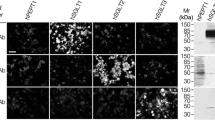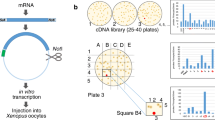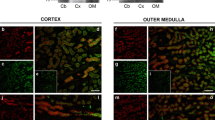Abstract.
We have previously partially purified the basolateral Na+/HCO− 3 cotransporter from rabbit renal cortex and this resulted in a 400-fold purification, and an SDS-PAGE analysis showed an enhancement of a protein band with a MW of approximately 56 kDa. We developed polyclonal antibodies against the Na+/HCO− 3 cotransporter by immunizing Dutch-belted rabbits with a partially purified protein fraction enriched in cotransporter activity. Western blot analysis of renal cortical basolateral membranes and of solubilized basolateral membrane proteins showed that the antibodies recognized a protein with a MW of approximately 56 kDa. The specificity of the purified antibodies against the Na+/HCO− 3 cotransporter was tested by immunoprecipitation. Solubilized basolateral membrane proteins enriched in Na+/HCO− 3 cotransporter activity were incubated with the purified antibody or with the preimmune IgG and then reconstituted in proteoliposomes. The purified antibody fraction caused a concentration-dependent inhibition of the Na+/HCO− 3 cotransporter activity, while the preimmune IgG failed to elicit any change. The inhibitory effect of the antibody was of the same magnitude whether it was added prior to (inside) or after (outside) reconstitution in proteoliposomes. In the presence of the substrates (NaHCO3 or Na2CO3) for the cotransporter, the inhibitory effect of the antibody on cotransporter activity was significantly blunted as compared with the inhibition observed in the absence of substrates. Western blot analysis of rabbit kidneys showed that the antibodies recognized strongly a 56 kDa protein band in microsomes of the inner stripe of outer medulla and inner medulla, but not in the outer stripe of outer medulla. A 56 kDa protein band was recognized in microsomes of the stomach, liver, esophagus, and small intestine but was not detected in red blood cell membranes. Localization of the Na+/HCO− 3 cotransporter protein by immunogold technique revealed specific labeling of the cotransporter on the basolateral membranes of the proximal tubules, but not in the brush border membranes. These results demonstrate that the polyclonal antibodies against the 56 kDa basolateral protein inhibit the activity of the Na+/HCO− 3 cotransporter suggesting that the 56 kDa protein represents the cotransporter or a component thereof. These antibodies interact at or near the substrate binding sites. The Na+/HCO cotransporter protein is expressed in different regions of the kidneys and in other tissues.
Similar content being viewed by others
Author information
Authors and Affiliations
Additional information
Received: 27 January 1996/Revised: 23 July 1996
Rights and permissions
About this article
Cite this article
Bernardo, A., Kear, F., Stim, J. et al. Renal Cortical Basolateral Na+/HCO− 3 Cotransporter: IV Characterization and Localization with Polyclonal Antibodies. J. Membrane Biol. 154, 155–162 (1996). https://doi.org/10.1007/s002329900140
Issue Date:
DOI: https://doi.org/10.1007/s002329900140




